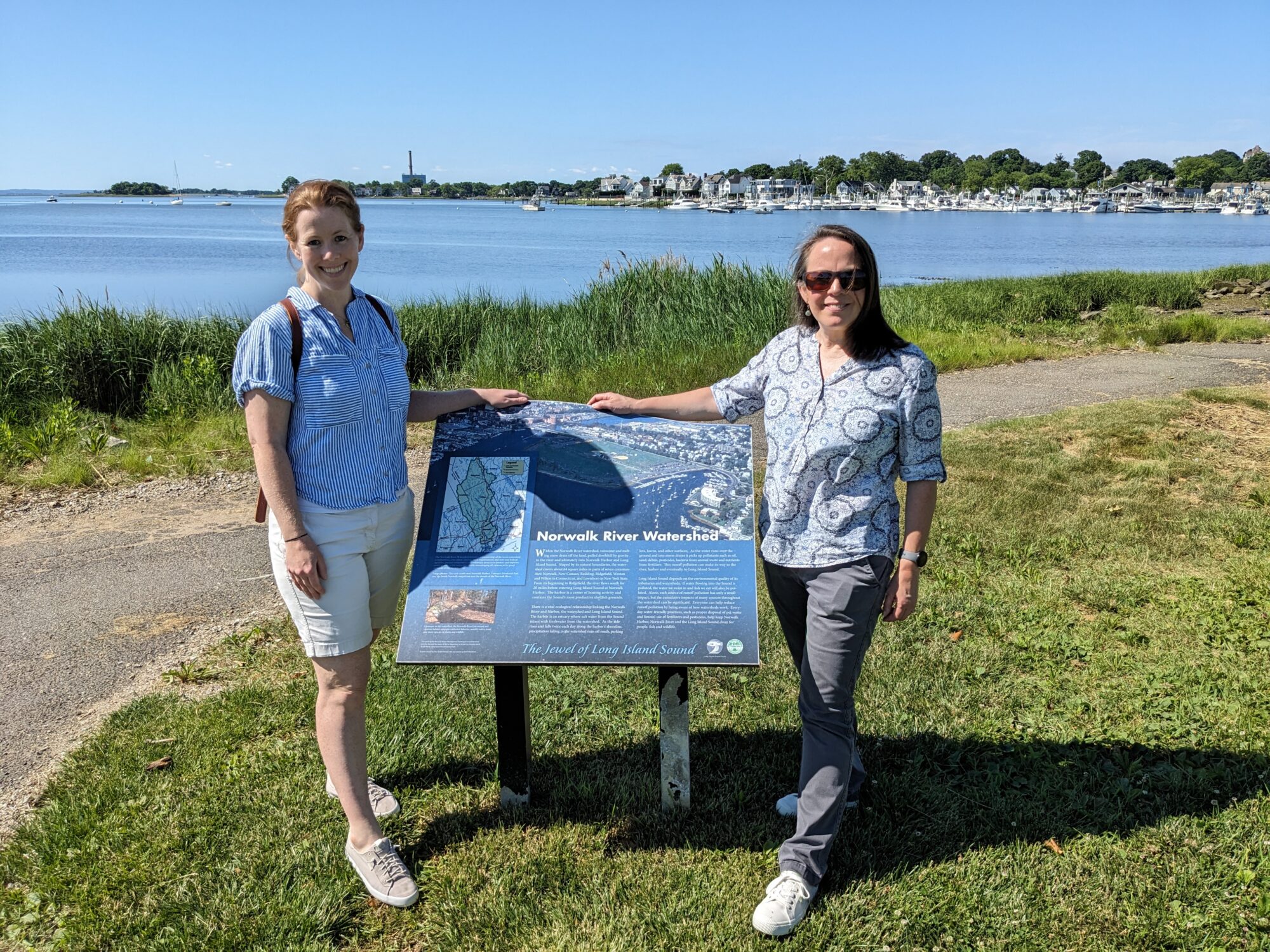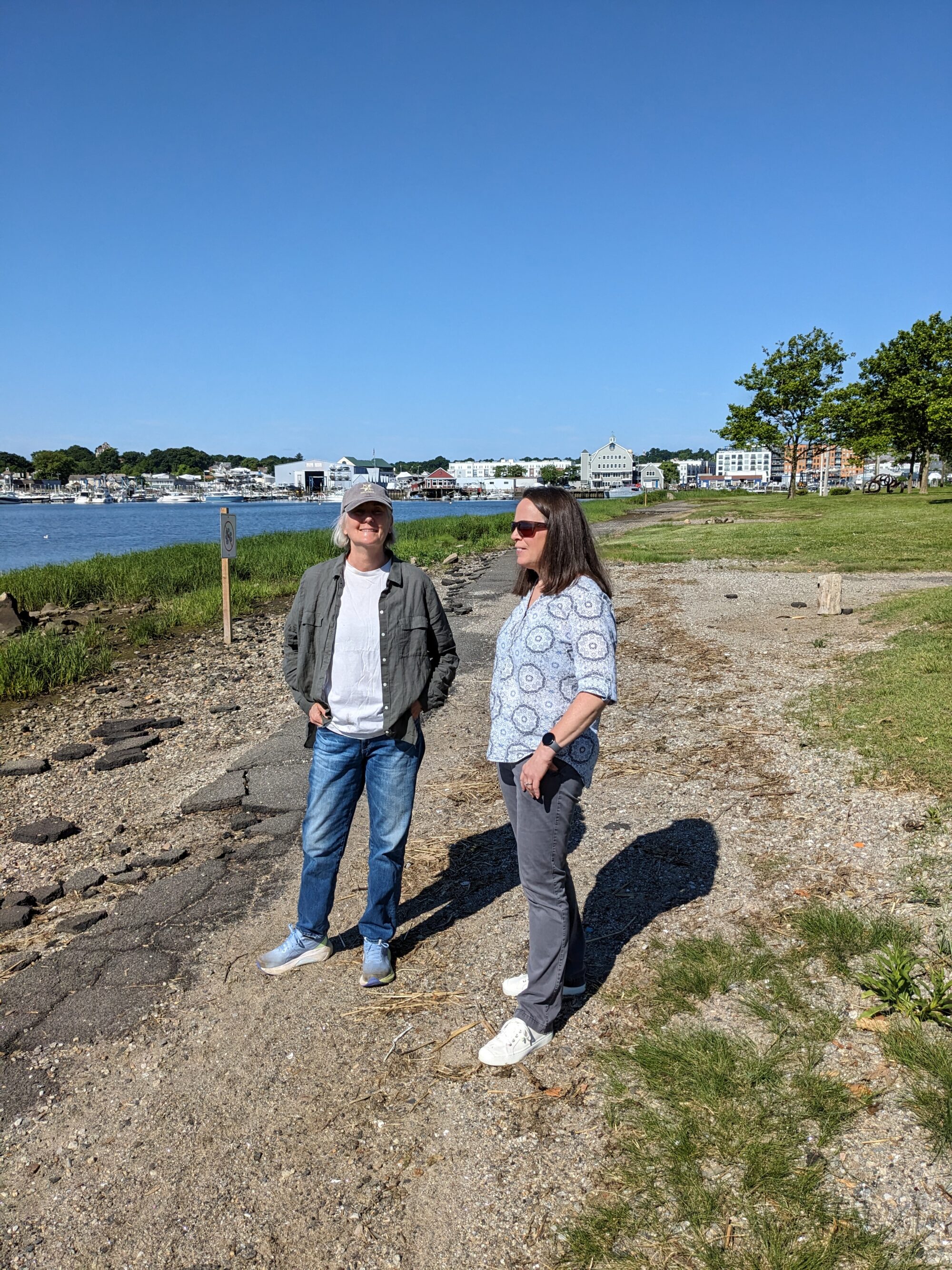Norwalk Eyes Green Designs to Make Urban Waterfront Park Resilient to Climate Change

If you walk along the path at the southern perimeter of Veterans Park, take in the sweeping view of Norwalk Harbor in downtown Norwalk. You might see egrets and other seabirds soaring and diving into the water. You will definitely see the rich heritage of a maritime-based community, including the home of one of the largest oyster processing facilities in Connecticut, marinas, seafood restaurants, and a public boat launch and dock.
At a distance, is the abundantly green Norwalk Islands and the vast expanse of Long Island Sound. It’s easy to see why this place is listed as a Long Island Sound Stewardship Area. It is one of 33 locations the Long Island Sound Study selected in the 2000s as unique natural and recreational resources along the coast.
At the same time, however, if you focus on the park itself, you will notice changes due to climate change that has left a negative impact. The asphalt walking path is crumbling due to the increased frequency and intensity of storms. Rainwater is coming from the skies, but brackish water is also coming into the park from the harbor with rising tides helped by elevated sea level rise. Alongside the path, the brackish water is encouraging the emergence of wetland grasses, which could be a good occurrence, but for now is competing with the traditional lawn the city is still trying to maintain. During intense, high-energy storms, the water from the Harbor also pours over an interior road into the park’s multipurpose recreational fields. Water could be coming from anywhere, including the Norwalk River and the park’s underground stormwater pipes, which are supposed to be sending stormwater from the land to Long Island Sound, but act in reverse by bringing water from the Harbor into the park.
“In the last five years it has just seemed like the whole park has been flooded just so much more frequently,” said Alexis Cherichetti, the city’s Senior Environmental Officer, while giving a tour of the park earlier this summer. “I remember that it had occurred once in the 15 years prior and now it’s once a year.”
In the 20th century and into the early 21st century, cities such as Norwalk perhaps would have looked toward constructing “grey” or hardened infrastructure to solve its flooding problem, including building sea walls or jetties. But these measures have proven unable to consistently keepup with emerging climate change threats like sea level rise. They can also damage the environment. So, Norwalk, with its partners, is looking at including nature-based solutions for Veterans Park through the help of two design projects funded by the Long Island Sound Futures Fund in 2022, a $92,000 grant award, and 2023, a $322,000 grant award. The first project, led by the Maritime Aquarium at Norwalk, involves reimagining the 12-acre southern perimeter as a vegetative buffer for the recreational fields with additional ecological benefits. The different design options being considered would restore the tidal marsh system that once existed in the park before the marsh was filled over in the 20th century. All the options include expanding the narrow band of Spartina alterniflora, a wetland grass, that still exists on the water’s edge and had once been abundant throughout the park. The grass, which is rooted in sediment between low and high tides and is salt tolerant can absorb water coming in from the coast helping to protect from flooding and erosion. The tall grasses also reduce the energy of waves and disperse them during storms, thus helping to reduce the amount of water pushing into the shores of the park from heavy rains and storm surges.

“As we are walking you will see that path is under disrepair and you can see on the right is an area that Recreation and Parks is still maintaining as a lawn,” said Cherichetti. “But there’s actually wetland vegetation growing in it. So, the idea is well, why are we working so hard to maintain this ( asphalt path and lawn) when maybe it would be better for all to expand the natural ecosystem. So, we have the opportunity for a natural buffer to protect what we know is important to the community, these active recreational fields.”
The popular recreational fields, which include four multipurpose fields and two soccer fields, make up most of the 36-acre park. A protective buffer in the southern perimeter would help protect the adjacent fields in the southern part of the park, but it won’t solve all the park’s flooding problems.
In the second phase of the design project, which is expected to begin in the fall Project partners will seek to improve resiliency, habitat, and public access for the entire park. Cherichetti said the plan will investigate both conventional projects, such as elevating the soccer fields near Seaview Avenue, as well as nature-based solutions. It is expected to take about a year and a half and will include a series of community meetings and “walkthroughs” to explain to community residents the importance of nature-based solutions in making the park resilient to climate change.
“Fields are in high demand,” said Cherichetti. “So, the city will need that time to really have the chance to articulate the reasons why this change is good and that there are positive benefits that benefit all.”
Even so, Cherichetti said that she expects there also will be many Norwalk residents who will enjoy seeing more nature in the park, particularly closest to the harbor.
“The city has heard this over and over again,” she said. “We recently did a master plan of parks and before that we did our plan of conservation and development and one thing that people talked about is water access but also access to natural lands. Any time you have a built environment like an urban core those natural spaces are real gems. They are special so we know that is something that is important to people.”
As for other ecological benefits of restoring the tidal marsh in the southern perimeter, tidal wetland grasses can absorb greenhouse gases such as carbon dioxide and improve water quality for the harbor by absorbing nitrogen runoff from stormwater. The tidal marsh system, which includes marsh grasses, mudflats, and dunes, is also a vital habitat for many coastal fish and animals. Mudflats, an area at the water’s edge visible during low tide, for example, are home to clams and oysters.
“I’m really excited about this project because not only is there an opportunity to obviously deal with erosion issues and public access issues but also it provides an opportunity in such a heavily developed part of the coastline to restore some of the natural habitat that was lost due to filling,” said Dr. Sarah Crosby, the Director of Conservation and Policy at the Maritime Aquarium at Norwalk.
Historically the site had been a tidal wetland and then it was a dump and then it was a park,” said Crosby. “So the plan is how can we incorporate some of the lost tidal wetlands back into the redesign of the park in such a way that we get some of those natural benefits back.”
Crosby’s new role at the Aquarium covers broad policy issues like climate change, species management, and marine pollution. She also leads conservation efforts for Long Island Sound, including redesigning the southern perimeter of the Veterans Park project. To support the project, Crosby has been collecting wildlife data with volunteer help during nature walks.
“We’ve been asking ‘What is the bird community that’s using the site’?” said Crosby. “And it’s actually a surprising diversity of birds that’s already here, but it will be really exciting as we progress hopefully, through this restoration project to see, how that grows and changes.”